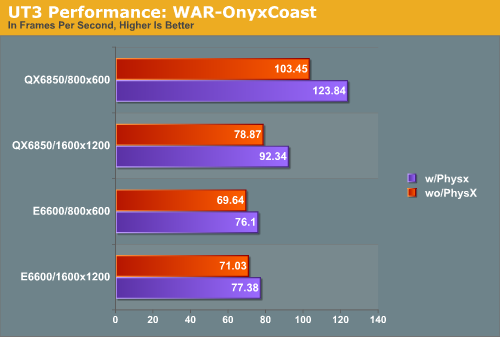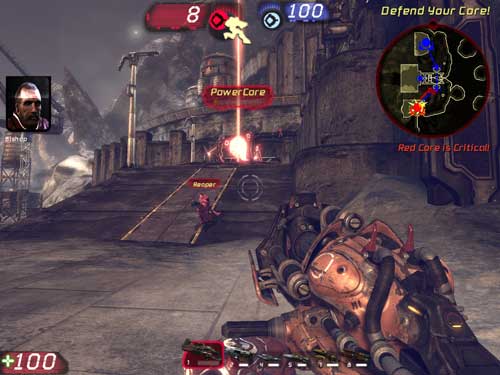PhysX’s Big Break? Unreal Tournament 3 PhysX Performance
by Ryan Smith on December 14, 2007 12:00 AM EST- Posted in
- GPUs
PhysX Performance Under UT3: Stock Maps
Moving on to performance with the stock UT3 maps, these do not involve any first-order physics to the best of our knowledge. However it’s still entirely possible to improve on second-order performance.

When we were originally benchmarking for this article, we started and intended to finish with WAR-OnyxCoast, an arctic-themed Warfare mode map that offers the full gamut of UT3 weapons and vehicles. What we found surprised us, so much in fact that we didn’t originally believe the results had we not been the ones doing benchmarking ourselves.
Against our initial expectations, WAR-OnyxCoast shows a performance improvement with the PhysX PPU installed, even with the light physics work being done. This is most obvious with our QX6850, where performance increases a respectable 15-20%. We ran this test several times more than the rest of our tests just to make sure this wasn’t a fluke or a product of botmatch variations and it’s not, there’s a definite performance improvement.
What’s driving this performance improvement we can only hypothesize on, compared to the more muted improvements with our E6600. Our best guess is that we’re CPU limited with the slower processor, with the limiting process being something other than physics (possibly bot AI), whereas that limit lifts with a faster processor. Of course we’d expect with more processing power the CPU would have no trouble keeping up with the PhysX PPU, but this doesn’t appear to be the case. It’s possible we’re still CPU and GPU limited on this map (explaining the change from 1600x1200 to 800x600), but we’re going to have to settle with the fact that we have a mystery on our hands for now.
Based on our results with WAR-OnyxCoast, we’ve also benchmarked CTF-Coret and WAR-Floodgate, to see if we can repeat those performance improvements, this time only with our QX6850.

Unlike WAR-OnyxCoast, neither of these maps showcases a large enough performance improvement with the PhysX hardware to positively confirm our earlier results. WAR-Floodgate is most like WAR-OnyxCoast out of these two additional maps, so it’s not particularly surprising that it peaks with an 8% performance improvement, but this is very close to the threshold for botmatch-induced variability, so it’s not conclusive. Meanwhile CTF-Coret flips between gaining and losing a marginal amount of performance, so we can be sure that it’s acting entirely within our experimental variability.
Looking at all of our results then, is the PhysX PPU improving performance under UT3’s stock maps? Probably. We can’t rule out other possibilities with the data we have, but our best explanation is that given a big enough map with enough players and vehicles, and enough of a computer to not be held down elsewhere, the PhysX PPU is giving us a measurable performance improvement of 10-20%. However we also have to keep in mind that with the frame rates we were already getting and the kinds of maps we believe this benefit is most pronounced on, that it’s not making a significant difference.











29 Comments
View All Comments
madgonad - Friday, December 14, 2007 - link
If most of the games arriving are enabled with this technology at a minimum it would give an equivalent boost of going from dual to quad core on regular maps using 2nd order physics. For games/maps using 1st order physics it would actually allow you to play them. For a $100 part (I have seen priced at $149) that might make sense if you have room in the case and PCIe 1x cards become available as a working product.For most of us, you know, people that build/buy a PC under a budget, this may or may not make sense. A physics processor may fall into the category of sound card since Vista and Realtek has taken great strides in making the previously mandatory sound card irrelevant. They might provide a couple "nice to have" features and slightly improve performance, but that money might be better spent on Crossfire or a faster CPU or better RAM or a mirrored hard disk.
The physics card is going to have to earn a place and this article does support that ability.
Heck, if it allows players to chew up the scenery I am all for it!
kilkennycat - Friday, December 14, 2007 - link
nVidia's upcoming dual-function next-gen silicon fully supporting either GPU or GPGPU functionality will finally kill PhysX. Wonder why the 780i chipset supports 3 PCIe16 slots and PCIe2.0? Think 2 GPUs in SLI dedicated to graphics and one GPU functioning as a GPGPU for bleeding-edge gaming. And for the less than bleeding-edge gaming, quad-core computation of bulk physics in combo with spare GPU horsepower for particle-effects will do quite nicely.Ryan Smith - Friday, December 14, 2007 - link
The funny thing is that at this time last year I'd agree with you, but now I'm not so sure.GPU physics has been a bust so far. ATI/NVIDIA made a bunch of noise when AGEIA announced their PPU, but HavokFX never came through and there is no other off-the-shelf solution that can do second-order physics, never mind first-order physics. It always seems like GPU physics in games is just around the corner and it never happens, and I'm not convinced that this misdirection from the GPU manufacturers is unintentional.
I keep hearing conflicting stories about when we'll get real GPU physics. Now the story is that things will finally be put in order forcefully by Microsoft in DirectX11, which is still years away (MS is still working on delivering DX10.1). This would coincide with some improvements in GPU threading that would help GPUs deal with the split workload, so it's very possible this is the case. Then again, both ATI and NVIDIA are finally delivering mature versions of their GPGPU programing environments (CUDA/CTM) which would allow someone to write a physics package at a lower level than shaders. I'm not aware of anyone working on this for games, though.
In the mean time the PPU does exist, and we expect we'll be seeing a far more powerful version fairly soon.
The 780i isn't the only chipset that supports 3 PCIe x16 slots either. I can show you some boards that came through here in 2005 that had the same support, for the exact same reason. Furthermore NVIDIA has a poor track record of supporting >2 GPUs in a system at once anyhow.
NickelPlate - Friday, December 14, 2007 - link
Let's hope so. The last thing PC gaming needs right now is another hardware requirement on the box.Martins - Friday, December 14, 2007 - link
So we don't need another Hardware requirement on the Box? In the form of a PPU that is $99 now and that as shown that can be faster them a $400+ dual core right? But you are not against the use of 3 or more GPU's and a new board if you want physics hardware acceleration, just do the math and see who gives us the best bung for ours money.NickelPlate - Friday, December 14, 2007 - link
I'm not saying their isn't a performance benefit. But the fact is PC gaming has slowly been taking the backseat to consoles over many years, mostly because it's getting more complicated and expensive for the average user. It's already depressing enough for most people to buy a high end graphics card only to have it chug on new games within years time. What's going to happen when they need a PPU upgrade every year also? Another $100? More? That's probably for the cheap ones. No doubt high end PPU cards will be end up costing hundreds.goku - Monday, December 17, 2007 - link
No, I think the problem is, pc gaming and well gaming in itself hasn't offered much innovation in a long time. A PPU would add a great amount of depth that is so sorely needed in today's games. What's the point of a high resolution tree if all you can do is cut it down in the same way as any other tree? Or how about driving a beautifully rendered car, but when you crash it, the damage is the same EVERYTIME.rykerabel - Wednesday, December 19, 2007 - link
wyrdI bought a physix just to put my money into encouraging some decent physics in the future.
I don't care which company succedes, i just want better physics period.
ChronoReverse - Friday, December 14, 2007 - link
Where are you getting this $400 dual core? Quad cores start at $279 now and dual cores can be had for less than $75 (soon even lower when the dual core Celerons come out).michal1980 - Friday, December 14, 2007 - link
I find that your statement of pc's not needed more new hardware just flat wrong.read the dailytech thread about display port. People are throughing themselves at a new port hand over fist. Those same people what physic's hard just because